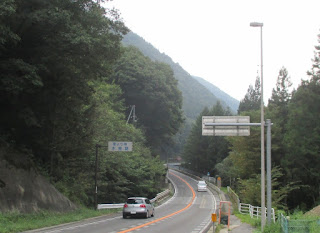There are 25 shukuba stations of Nakasendo in Nagano Prefecture (Shinshu in old name). I walked the first 13 stations in the eastern part of Nagano this spring. It was from Karuizawa, the 18th station from Nihonbashi to Shiojiri, the 30th.
I
resumed my walk today. It was from Shiojiri to Niekawa, the 33rd station.
Shiojiri
is an important transportation hub. The roads and railways from Tokyo, Nagoya
and Niigata areas meet here.
The rails go eastwards to Tokyo and westwards to Nagoya from JR Shiojiri Station. The window’s decoration is grape design.
The rails go eastwards to Tokyo and westwards to Nagoya from JR Shiojiri Station. The window’s decoration is grape design.
The
area grows good grape and produces wines. They had “the Grape Festival” as
September and October are the harvest season.
There
are many grape fields along the roads. (see also the 2nd photo from the top)
Grape picking services were offered in many farms.
Grape picking services were offered in many farms.
I
also saw the fields of lettuce, cabbage and other vegetables.
There is an archaeological site at the side of Nakasendo on the way to Seba, the 31st station. It is called Hirade remains. The houses of Jomon era (B.C 13-B.C.4 century), Kofun era (A.D. 3-7 century), and Heian era (A.D.8-12 century) are rebuilt. (see also the 3rd photo from the top)
There is an archaeological site at the side of Nakasendo on the way to Seba, the 31st station. It is called Hirade remains. The houses of Jomon era (B.C 13-B.C.4 century), Kofun era (A.D. 3-7 century), and Heian era (A.D.8-12 century) are rebuilt. (see also the 3rd photo from the top)
The
grape fields spread around the remains.
There remains a set of milestone in the area. The rice fields behind were shinning gold.
There remains a set of milestone in the area. The rice fields behind were shinning gold.
I
walked into the area of Seba station. I saw houses as well as vegetable and rice fields spread in the narrow lands
between the mountains (see also the 4th photo from the top).
Autumn flowers were beautiful at the side of the road.
Autumn flowers were beautiful at the side of the road.
There
is a legend that Minamoto Yoshinaka, one of the heroes in the 12th
century (late Heian era) washed his horse in the well here. The
overflowing water was clean and cold.
I saw many fields of soba (buckwhest)
on the way to Motoyama, the 32nd station. The flower is white.
Soba
was eaten from ancient days, but it was the Edo ear when people began to cook
soba as noodle. The new style started here in Motoyama.
I
walked southwards and arrived Sakurazawa area.. There is a stone monument at
the side of the road.
It
says: the starting point of Kiso road, down to south.
There
are 11 shukuba stations in Kiso road. I arrived in Niekawa, the first station
of the Kiso road and the 33rd station from Tokyo’s Nihonbashi.





















No comments:
Post a Comment